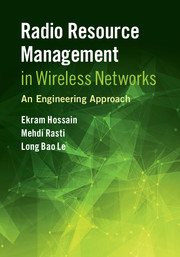Book contents
- Frontmatter
- Contents
- Preface
- Part I Basics of Wireless Networks
- Part II Techniques for Modeling and Analysis of Radio Resource Allocation Methods in Wireless Networks
- Part III Physical Layer Resource Allocation in Wireless Networks
- 5 General System Model and Preliminary Concepts
- 6 Power Control in Cellular Wireless Networks
- 7 Distributed Joint Power and Admission Control
- 8 Joint Power and Admission Control in Cognitive Radio Networks
- 9 Cell Association in Cellular Networks
- Part IV Link Layer Resource Allocation in Wireless Networks
- Part V Cross-Layer Modeling for Resource Allocation in Wireless Networks
- Index
- References
6 - Power Control in Cellular Wireless Networks
from Part III - Physical Layer Resource Allocation in Wireless Networks
Published online by Cambridge University Press: 11 May 2017
- Frontmatter
- Contents
- Preface
- Part I Basics of Wireless Networks
- Part II Techniques for Modeling and Analysis of Radio Resource Allocation Methods in Wireless Networks
- Part III Physical Layer Resource Allocation in Wireless Networks
- 5 General System Model and Preliminary Concepts
- 6 Power Control in Cellular Wireless Networks
- 7 Distributed Joint Power and Admission Control
- 8 Joint Power and Admission Control in Cognitive Radio Networks
- 9 Cell Association in Cellular Networks
- Part IV Link Layer Resource Allocation in Wireless Networks
- Part V Cross-Layer Modeling for Resource Allocation in Wireless Networks
- Index
- References
Summary
For a wireless network, the transmit power is one of the main radio resources. Two major objectives of power control in a wireless network are to extend UEs’ battery life and to maintain an acceptable QoS (e.g., in terms of the SINR or throughput) for all UEs by minimizing interferences to UEs. Data services require a higher SINR (as a measure of QoS) as compared to the voice service, because the latter is more tolerant to bit errors. In contrast to the voice service for which the QoS is measured by a step function of the SINR [1], the commonly used QoS measure for the data service is, in general, an increasing function of the SINR.
A distributed scheme for power control is preferred to a centralized one, because in the former, the transmit power level of a user is decided by that user by utilizing the locally available information and uses minimal feedback from the BS. In this way, the need for frequent power setting commands by the BS are avoided, and the processing capabilities at the BS needed to obtain the instantaneous uplink power levels of all UEs are substantially reduced. In contrast, a centralized approach needs to have information about path-gains and throughput requirements for all UEs at the BS.
In this chapter, we first discuss why power control is needed and state the objectives of power control, followed by a discussion on conventional open/closed loop and centralized power control algorithms. Then various existing distributed power control algorithms are presented and evaluated according to different criteria.
Objectives of Power Control
In Chapter 5, we studied the relation between transmit power and SINR vectors. We know that the achieved SINRs by UEs at uplink or downlink determine their experienced QoS. Now the question is how the predetermined target QoS for users can be achieved. The transmit power cannot be set at random or at a fixed level by the UEs. For example, if the UEs served by the same cell transmit at the same fixed power level, the SINR for the UEs with good path-gains (e.g., those near the BS) are high, whereas for the far UEs it will be low. This is called the near-far problem, which can be addressed if the transmit power is dynamically controlled.
Information
- Type
- Chapter
- Information
- Radio Resource Management in Wireless NetworksAn Engineering Approach, pp. 207 - 230Publisher: Cambridge University PressPrint publication year: 2017
References
Accessibility standard: Unknown
Why this information is here
This section outlines the accessibility features of this content - including support for screen readers, full keyboard navigation and high-contrast display options. This may not be relevant for you.Accessibility Information
- 1
- Cited by
